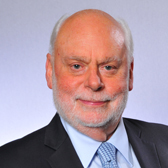Sir Fraser Stoddart

Fraser Stoddart
2016 Nobel Prize in Chemistry
Behind Professor Sir Fraser Stoddart’s works lie poetic motivations: he saw much beauty in the field of chemistry, and in turn, an opportunity to sculpt, paint and compose at the molecular level. It was this profound perspective of the field that drove Sir Fraser to sculpt his Magnum opus—the rotaxane molecule.
Mechanical bonds are the prime interest of Sir Fraser’s research. The field involves the formulation of mechanical constraints to hold parts of a molecule together, such as by interlocking two ring-shaped compounds to keep them from separating. In 1991, Sir Fraser used such bonds to develop rotaxane, which consisted of a molecular ring threaded onto a molecular axle.
Sir Fraser’s demonstration of the ring’s ability to move back and forth along the axle mirrored the vital ability of a machine’s components to move relative to each other in order for the machine to function. Sir Fraser was thus jointly awarded the Nobel Prize in Chemistry for the design and synthesis of molecule machines in 2016. According to the Nobel Prize committee, the invention was a hopeful precedent for a new field of technology where “molecule machines could be used for new materials, sensors and energy storage systems”.
In an article written for Nature Nanotechnology, Sir Fraser credited his discovery of mechanical bonds to the X-ray crystallography expertise of David Williams at Imperial College, with whom he had worked closely from 1974 to 1991. He believes collaborations to have been essential throughout his career, writing that, “Oftentimes, by far the best outcomes in science are the result of collaborations.”
From 1997, Sir Fraser spent 10 years with the University of California, Los Angeles (UCLA), developing rotaxane-based technology in collaboration with the California NanoSystems Institute (CNSI), which he became the Acting Co-Director of in 2002. He transformed rotaxanes into various molecule machines, from artificial muscles to computer chips. He believes that mechanical bonds open doors to a world of possibilities, and that these developments were just the beginning. Sir Fraser has since received numerous awards for his work, such as the Nagoya Gold Medal in Organic Chemistry (2004) and the Albert Einstein World Award of Science (2007).
In his time at Northwestern University in Illinois from 2008 to the present, Sir Fraser has shifted gears towards mentorship. As a Board of Trustees Professor of Chemistry and head of the Stoddart Mechanostereochemistry Group at the University, he strives to nurture a new generation of trailblazing chemists. He has also established a research laboratory in Tianjin University in China to support young scientists. To him, the hundreds of graduate students and postdoctoral fellows that he has mentored are his greatest legacy.
Echoing his former PhD examiner’s words to him before he embarked on his research career, Sir Fraser wishes for rising scientists to “tackle a big problem”. He encourages them to venture beyond the well-trodden areas of research to find the next big problem in science.

